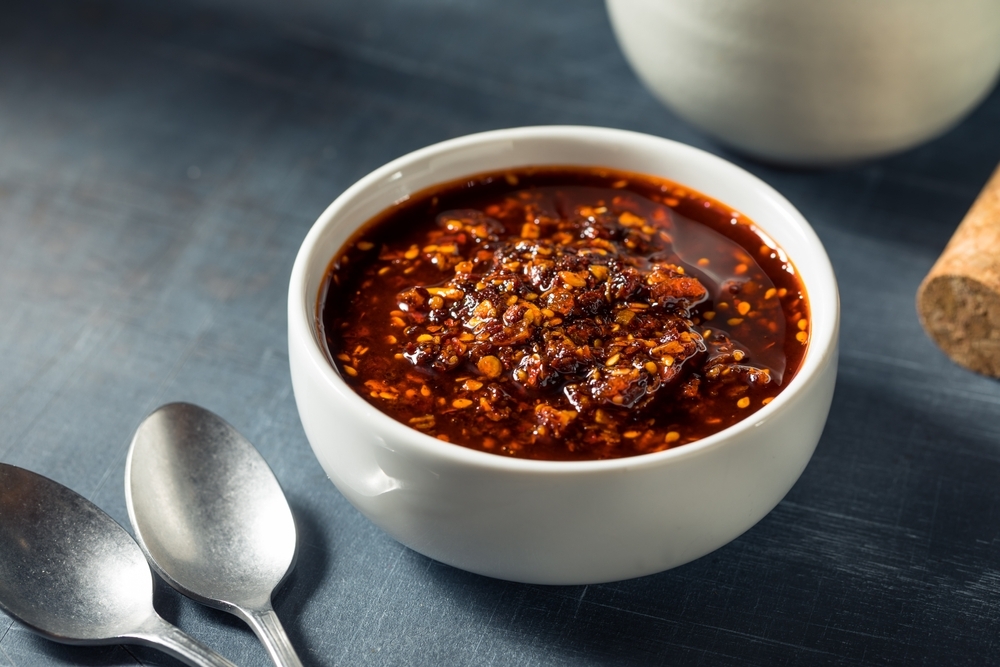Posted on April 16, 2024

Trade mark bullying or reasonable brand protection?
The food company Momofuku has recently caused a stir in the US with a cease and desist letter campaign seeking to prevent use by other companies of the phrase CHILI CRUNCH for a popular Chinese spicy condiment. This case is interesting as it highlights once again the thorny issue of how a big entity should enforce their rights against smaller players in their market. It also raises the question of where the line should be drawn when granting a monopoly over what could be seen simply as a product name.
This has been reported as another David v Goliath-style matter, with Momofuku being portrayed as a trade mark bully. That impression is not helped as, reportedly, many of the recipients of their cease and desist letters are very small operations with limited resources, whereas Momofuku is a large, well-funded entity.
Should Momofuku be allowed to stop other food companies from using the name CHILI CRUNCH for chilli condiments?
As always, the real answer comes down to the specific facts.
Momofuku are reportedly claiming to have common law rights in the name CHILI CRUNCH by virtue of the use they have made of it, with jars of their CHILI CRUNCH having been on sale since 2020.
They currently do not have a US Trade Mark Registration for CHILI CRUNCH, as their US Trade Mark Application was only filed on 29 March 2024. Even if the Application does not encounter any objections, it is likely to take around a year to achieve registration.
On the other hand, Momofuku do own a US Trade Mark Registration of the mark CHILE CRUNCH for “Condiments, namely, salsa; sauces”, which was registered in 2015. According to the Guardian, Momofuku acquired that Registration in 2023 from the Denver company Chile Colonial, LLC as part of a legal settlement. Apparently, Chile Crunch is the brand name of a chilli condiment made by Chile Colonial, which has been on the market for more than a decade. The word CHILE is the Spanish word for CHILI, and the two are visually and phonetically similar, so arguably use by other companies of CHILI CRUNCH could possibly be deemed to infringe the earlier Registration of CHILE CRUNCH.
But should it have been possible to register the name CHILE CRUNCH for chilli condiments at all?
Variations on a crunchy, crispy chilli oil, originating from China, have become increasingly popular in the mainstream in recent years. The Guardian reports a Chinese food expert as saying “chili condiments have existed in China for a very long time, and each family, restaurant, company and region has their own recipe and nomenclature. Translating these various chili condiment types into English word-for-word for the US consumer can be clunky, like “fragrant, spicy and crisp”, for example, likely to leave a US consumer puzzled. Labels need to be able to describe chili condiments for mainstream consumers.” In this sector, it does not seem to be entirely clear whether there is a recognised English descriptive name for the product, but that doesn’t necessarily mean there is a need for other companies to use the name CHILI CRUNCH or confusingly similar variants thereof.
The US Patent and Trade Mark Office (USPTO) examines all trade applications to consider whether the mark applied for can function as an indication of trade origin for the goods covered. They will refuse to register marks that they consider to be descriptive of those goods or of their characteristics. In this case, we don’t know the precise circumstances, but the relevant US Examiner in 2015 must have considered the mark CHILE CRUNCH to be sufficiently distinctive to function as a badge of origin for condiments.
It is possible to seek to have an existing trade mark registration cancelled on the basis that it should not have been registered. However, the precise requirements for success in a cancellation action depend on the jurisdiction, and typically the onus is on the party seeking to cancel the registration to provide convincing evidence to prove their case.

Could Momofuku have handled this matter better?
Quite possibly, although without access to copies of the cease and desist letters, it is difficult to say for sure.
Given that Momofuku own a relevant trade mark registration, it is reasonable for them to seek to enforce their rights. That would include seeking to stop third parties from using marks which could lead to consumer confusion or risk damaging their own reputation. In fact, turning a blind eye to the use of a registered trade mark by multiple unconnected companies can lead to the mark becoming generic, as happened historically with marks like ESCALATOR and ASPIRIN. That can then result in the original trade mark registration being cancelled.
Sending cease and desist letters as a warning shot before commencing legal proceedings is also good practice, as it puts the alleged infringer on notice and allows them to seek to rectify the matter without having to incur significant legal costs. Obviously, companies should not be threatening people without having reasonable grounds to do so, but the mere fact of launching a campaign sending cease and desist letters to a number of companies should not in itself be seen as bullying behaviour.
The fact that a company is using a phrase in good faith, without any intention to infringe earlier rights, is not a defence to trade mark infringement. It is preferable for a small company to be alerted early that their brand is too close to a registered trade mark. The more a business and its reputation have grown under a particular brand, the more expensive it can be if they are then forced to change that brand.
In the era of social media, where any written communication can be made public in an instant, the drafting of a cease and desist letter needs very careful thought, and it may be prudent to avoid use of an overly aggressive tone. Before launching an enforcement campaign, careful consideration needs to be given to how the sender’s reputation could be affected, whether all publicity really is good publicity, and whether the desired commercial outcome of the campaign is worth any negative reaction from the media and consumers. That should all then feed into devising a suitable strategy.
We would need more information to decide categorically whether Momofuku have taken the right approach in this matter. From one viewpoint, they could be seen as seeking to restrict competition by preventing honest traders from legitimately using a descriptive term. An alternative view would be that they are simply seeking to protect the investment they have made in their brand and associated reputation.
What can we learn from this?
When adopting a product name:
- Stories such as this highlight the need to check carefully whether you are free to adopt all aspects of a product name before committing to that mark. CHILI CRUNCH may well have seemed like a descriptive term to the various condiment producers, but CHILE CRUNCH had been registered in the US since 2015. Early trade mark searches in key markets of interest can reduce the risk of encountering nasty surprises as your brand takes off.
If you are the proprietor of a brand which could arguably be seen as descriptive:
- If you want to be able to prevent others from using a particular term, do your research before adopting the mark. If several other parties are using the term already in your sector in a descriptive sense, you are unlikely to be able to stop that, or to obtain your own enforceable trade mark registration.
- As a general rule, trade marks should be used as adjectives (eg CHILI CRUNCH crispy chilli oil) and not as nouns or verbs. Other companies making a similar product can use the generic noun, but should steer clear of using your trade mark.
- Think about using the TM symbol beside terms that you consider to be your brands, wherever they appear on your packaging and marketing material. That symbol has no particular legal meaning so can be used even when a trade mark has not been registered.
If you are a brand owner looking to enforce your rights:
- Consider precisely what you are trying to achieve, and what level of action is proportionate in the circumstances.
- Think about whether you have sufficient rights to support your case.
- Where you do have a good case and sound commercial reasons, don’t be afraid to take action against infringers. Failure to do so could potentially erode your registered trade mark rights in the future.
- Bear in mind that any letter sent on your behalf could end up on social media! Tailor your approach on that basis.
We are a European firm and assist our clients to protect their IP rights in the UK, Europe and worldwide from our offices in the UK and The Netherlands and through our international network of trusted local attorneys.
Get in touch if you would like to discuss your innovations and brand protection further.
